Alpine INE-S900R Owner Manual

FOR CAR USE ONLY
R |
EN |
|
Advanced Navi Station
INE-S900R
OWNER’S MANUAL
Please read before using this equipment.
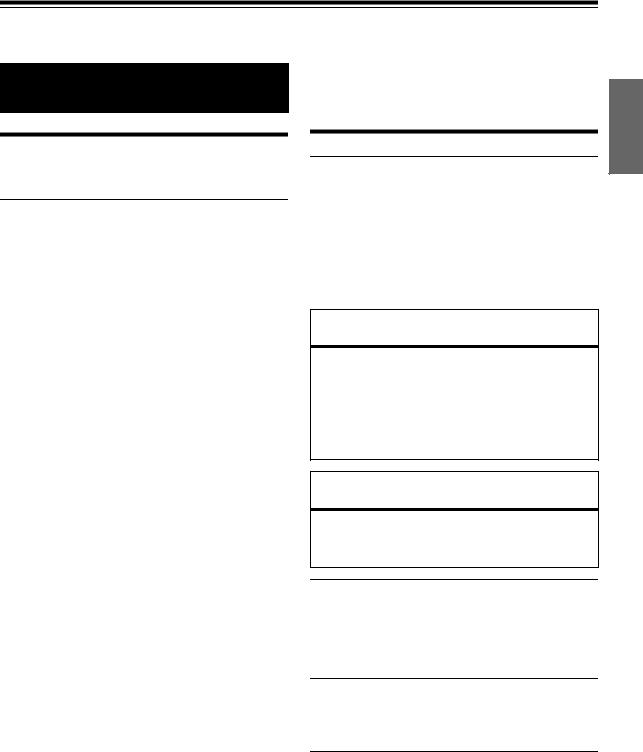
Operating Instructions
PRECAUTIONS
IMPORTANT INFORMATION, PLEASE READ CAREFULLY BEFORE USING THIS PRODUCT.
This product is intended to safely provide turn-by-turn instructions to get you to a desired destination. Please read the following precautions to ensure that you use this navigation system correctly.
•This product is not a substitute for your personal judgment. Any route suggestions made by this navigation system should never supersede any local traffic regulations or your personal judgment and/or knowledge of safe driving practices. Do not follow route suggestions if the navigation system instructs you to perform an unsafe or illegal manoeuvre, places you in an unsafe situation, or routes you into an area which you consider unsafe.
•Glance at the screen only when necessary and safe to do so. If prolonged viewing of the screen is necessary, stop in a safe and legal manner and location.
•Do not input destinations, change settings, or access any functions requiring a prolonged view of the monitor while you are driving. Stop in a safe and legal manner and location before attempting to access the system.
•When using the navigation system to find/route to an emergency service, please contact the facility to validate and verify availability, prior to driving to it. Not all locations of emergency service providers such as police and fire stations, hospitals, and clinics are contained in the database. Please use your own judgment and your ability to ask for directions in these situations.
•The map database contained within the media (SD memory card) in which it is stored is the most recent map data available at the time of production. Because of changes in streets and neighborhoods, there may be situations where the navigation system may not be able to route you to your desired destination. In these cases, use your own personal judgment.
•The map database is designed to provide you with route suggestions, it does not take account of the relative safety of a suggested route, or of factors which may affect the time required to reach your destination. The system does not reflect road closures or construction, road characteristics (i.e. type of road surface, slope or grade, weight or height restrictions, etc.), traffic congestion, weather conditions, or any other factors which may affect the safety or timing of your driving experience. Use your personal judgment if the navigation system is unable to provide you with an alternate route.
•There may be situations where the navigation system may display the vehicle’s location erroneously. Use your own driving judgment in this situation, taking into account current driving conditions. Please be aware that in this situation, the navigation system should correct the vehicle’s position automatically; however, there may be times where you may have to correct the position yourself. If this is the case, stop in a safe and legal manner and location before attempting operation.
•Make certain that the volume level of the unit is set to a level which still allows you to hear outside traffic and emergency vehicles. Driving while unable to hear outside sounds could cause an accident.
•Please make certain that any other person who intends on using this navigation system reads these precautions and the following instructions carefully.
If there is anything in the manual about the operation of the navigation system which you are uncertain about, please contact your local Alpine authorized navigation dealer before using the navigation system.
Points to Observe for Safe Usage
•Read this manual carefully before using this disc and the system components. They contain instructions on how to use this product in a safe and effective manner. Alpine cannot be responsible for problems resulting from failure to observe the instructions in this manual.
•This manual uses various pictorial displays to show you how to use this product safely and to alert you to potential dangers resulting from improper connections and operation. Following are the meanings of these pictorial displays. It is important to fully understand the meanings of these pictorial displays in order to use this manual and the system properly.
 WARNING
WARNING
•Operation of the system while driving is dangerous. Users should stop vehicle before operating the software.
•Road conditions and regulations take precedence over information contained on the map display: observe actual traffic restrictions and circumstances while driving.
•This software is designed for use exclusively in the INES900R. It cannot and may not be used in conjunction with other hardware.
 WARNING
WARNING
This symbol means important instructions. Failure to heed them can result in serious injury or death.
DO NOT OPERATE ANY FUNCTION THAT TAKES YOUR ATTENTION AWAY FROM SAFELY DRIVING YOUR VEHICLE.
Any function that requires your prolonged attention should only be performed after coming to a complete stop. Always stop the vehicle in a safe location before performing these functions.
Failure to do so may result in an accident.
KEEP SMALL OBJECTS SUCH AS SCREWS OUT OF THE REACH OF CHILDREN.
Swallowing them may result in serious injury. If swallowed, consult a physician immediately.
MINIMIZE DISPLAY VIEWING WHILE DRIVING.
Viewing the display may distract the driver from looking ahead of the vehicle and cause an accident.
1-EN

DO NOT FOLLOW ROUTE SUGGESTIONS IF THE NAVIGATION SYSTEM INSTRUCTS YOU TO PERFORM AN UNSAFE OR ILLEGAL MANOEUVRE, OR PLACES YOU IN AN UNSAFE SITUATION OR AREA.
This product is not a substitute for your personal judgment. Any route suggestions by this system should never supersede any local traffic regulations or your personal judgment or knowledge of safe driving practice.
KEEP THE VOLUME AT A LEVEL WHERE YOU CAN STILL HEAR OUTSIDE NOISES WHILE DRIVING.
Excessive volume levels that obscure sounds such as emergency vehicle sirens or road warning signals (train crossings, etc.) can be dangerous and may result in an accident. LISTENING AT LOUD VOLUME LEVELS IN A CAR MAY ALSO CAUSE HEARING DAMAGE.
DO NOT DISASSEMBLE OR ALTER.
Doing so may result in an accident, fire or electric shock.
USE ONLY IN CARS WITH A 12 VOLT NEGATIVE GROUND.
(Check with your dealer if you are not sure.) Failure to do so may result in fire, etc.
USE THE CORRECT AMPERE RATING WHEN REPLACING FUSES.
Failure to do so may result in fire or electric shock.
DO NOT BLOCK VENTS OR RADIATOR PANELS.
Doing so may cause heat to build up inside and may result in fire.
USE THIS PRODUCT FOR MOBILE 12V APPLICATIONS.
Use for other than its designed application may result in fire, electric shock or other injury.
DO NOT PLACE HANDS, FINGERS OR FOREIGN OBJECTS IN INSERTION SLOTS OR GAPS.
Doing so may result in personal injury or damage to the product.
 CAUTION
CAUTION
This symbol means important instructions. Failure to heed them can result in injury or material property damage.
HALT USE IMMEDIATELY IF A PROBLEM APPEARS.
Failure to do so may cause personal injury or damage to the product. Return it to your authorized Alpine dealer or the nearest Alpine Service Centre for repairing.
2-EN
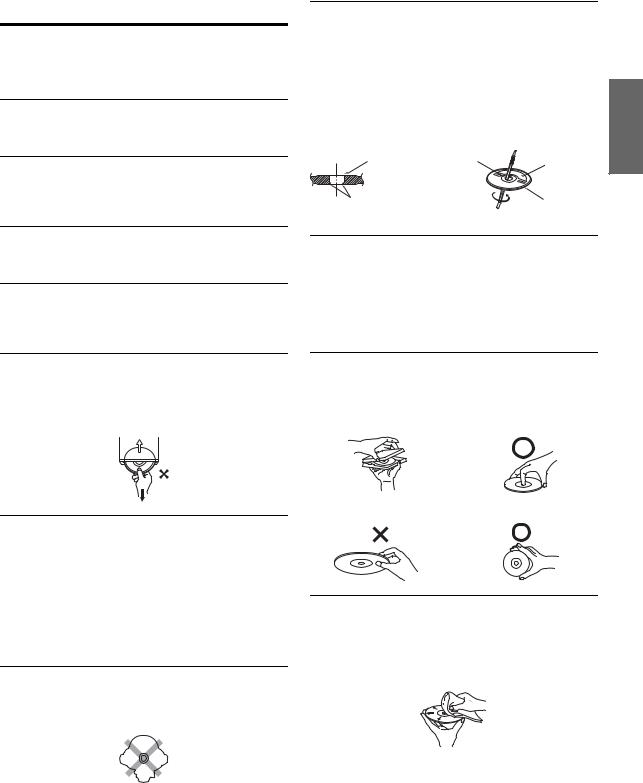
 PRECAUTIONS
PRECAUTIONS
Product Cleaning
Use a soft dry cloth for periodic cleaning of the product. For more severe stains, please dampen the cloth with water only. Anything else has the chance of dissolving the paint or damaging the plastic.
Temperature
Be sure the temperature inside the vehicle is between +45°C (+113°F) and 0°C (+32°F) before turning your unit on.
Moisture Condensation
You may notice the disc playback sound wavering due to condensation. If this happens, remove the disc from the player and wait about an hour for the moisture to evaporate.
Damaged Disc
Do not attempt to play cracked, warped, or damaged discs. Playing a bad disc could severely damage the playback mechanism.
Maintenance
If you have problems, do not attempt to repair the unit yourself. Return it to your Alpine dealer or the nearest Alpine Service Station for servicing.
New Discs
To prevent the CD from jamming, “Unable to read Disc.” is displayed if discs with irregular surfaces are inserted or if discs are inserted incorrectly. When a new disc is ejected immediately after initial loading, use your finger to feel around the inside of the centre hole and outside edge of the disc. If you feel any small bumps or irregularities, this could inhibit proper loading of the disc. To remove the bumps, rub the inside edge of the hole and outside edge of the disc with a ballpoint pen or other such instrument, then insert the disc again.
Centre Hole |
Centre Hole |
|
New Disc |
||
|
||
Bumps |
Outside |
|
(Bumps) |
||
|
Installation Location
Make sure the INE-S900R will not be installed in a location subjected to:
•Direct sun and heat
•High humidity and water
•Excessive dust
•Excessive vibrations
Never Attempt the Following
Do not grip or pull out the disc while it is being pulled back into the player by the automatic reloading mechanism.
Do not attempt to insert a disc into the unit when the unit power is off.
Correct Handling
Do not drop the disc while handling. Hold the disc so you will not leave fingerprints on the surface. Do not affix tape, paper, or gummed labels to the disc. Do not write on the disc.
CORRECT
Inserting Discs
Your player accepts only one disc at a time for playback. Do not attempt to load more than one disc.
Make sure the label side is facing up when you insert the disc. “Unable to read Disc.” will be displayed on your player if you insert a disc incorrectly. If “Unable to read Disc.” continues to be displayed even though the disc has been inserted correctly, push the RESET switch with a pointed object such as a ballpoint pen. Playing a disc while driving on a very bumpy road may result in skips, but this will not scratch the disc or damage the player.
Irregular Shaped Discs
Be sure to use round shaped discs only for this unit and never use any special shaped discs.
Use of special shaped discs may cause damage to the mechanism.
INCORRECT |
CORRECT |
Disc Cleaning
Fingerprints, dust, or soil on the surface of the disc could cause the DVD player to skip. For routine cleaning, wipe the playing surface with a clean, soft cloth from the centre of the disc to the outer edge. If the surface is heavily soiled, dampen a clean, soft cloth in a solution of mild neutral detergent before cleaning the disc.
3-EN
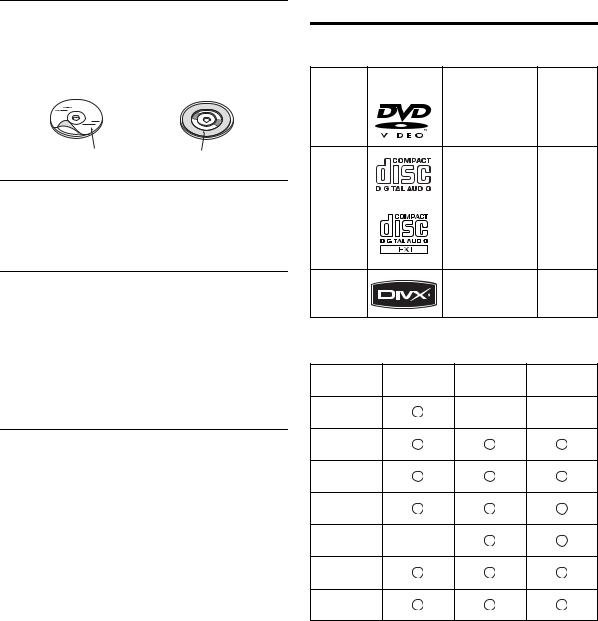
Disc Accessories
There are various accessories available on the market for protecting the disc surface and improving sound quality. However, most of them will influence the thickness and/or diameter of the disc. Using such accessories can cause operational problems. We recommend not using these accessories on discs played in INE-S900R.
Transparent Sheet |
Disc Stabilizer |
•After turning the system off, a slight ghost of the image will remain temporarily. This is an effect peculiar to LCD technology and is normal.
•In cold temperature conditions, the screen may lose contrast temporarily. After a short warm-up period, it will return to normal.
Operation of some of the functions of this unit is very complex. Because of this, it was deemed necessary to place these functions into a special screen. This will restrict operation of these functions to times when the vehicle is parked. This ensures the focus of the driver’s attention will be on the road and not on the INE-S900R. This has been done for the safety of the driver and passengers. The car must be parked and the parking brake must be engaged for the procedure described in the Owner’s Manual to be valid. The warning “No operation while driving - for your safety” will be displayed if any attempts are made to perform these operations while driving.
•The INE-S900R draws minimal current even when its power switch is turned off. If the switched power (ignition) lead of the INE-S900R is connected directly to the positive (+) post of the vehicle’s battery, the battery may be discharged.
An SPST (Single-Pole, Single-Throw) switch (sold separately) can be added to simplify this procedure. Then, you can simply place it in the OFF position when you leave the vehicle. Turn the SPST switch back ON before using the INE-S900R. For connecting the SPST switch, refer to the “Connection Diagram of SPST Switch (Sold Separately)” (page 139). If the power (ignition) lead is unswitched, it must be disconnected from the battery post should the vehicle be left unused for an extended period of time.
Discs Playable on This Unit
Playable Discs
The discs listed below can be played on this unit.
Mark (logo) |
Recorded Content |
Disc size |
|||
|
|
|
|
|
|
DVD Video |
Audio + Video |
12 cm* |
|||
|
|
|
|
|
|
|
|
|
|
|
|
|
|
|
|
|
|
|
|
|
|
|
|
Music CD |
|
|
Audio |
12 cm |
|
|
|
|
|
|
|
|
|
|
DivX® |
Audio + Video |
12 cm |
* Two-layer DVD disc compatible
The formatted discs listed below can be played on this unit.
CD-R/ |
DVD-R/ |
DVD+R/ |
CD-RW |
DVD-RW |
DVD+RW |
CD
Format
MP3 Format (“mp3”)
WMA Format (“wma”)
AAC Format (“m4a”)
DVD Video
Format
DivX Format (“avi”, “divx”)
ASF Format (“asf”)
• Discs that are not finalised cannot be played back.
4-EN
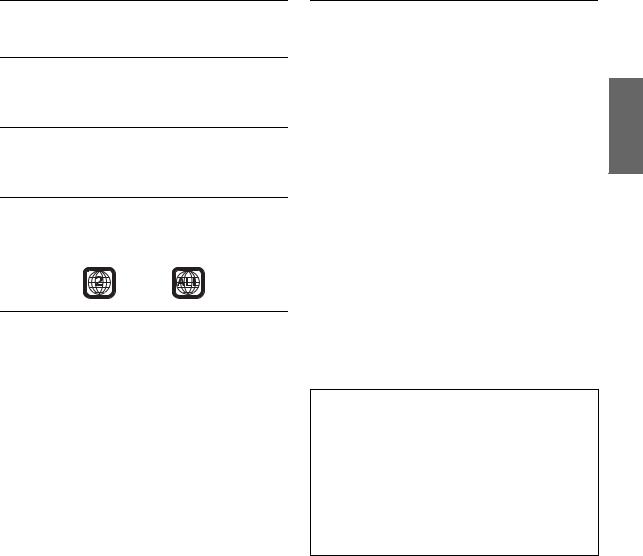
Discs that cannot be played
DVD-RAMs, CD-ROMs (excluding MP3/WMA/AAC files), Video CD, photo CDs, etc.
DualDisc
This unit is not compatible with DualDisc.
Using a DualDisc may cause unit malfunction, and may cause disc damage when the disc is inserted/ejected.
Double-sided DVD
This unit is not compatible with double-sided DVD.
Using a double-sided DVD may cause unit malfunction, and may cause disc damage when the disc is inserted/ejected.
DVD region number (playable region number)
This DVD player will play back any disc whose region number is 2 (or All). DVDs with a region number other than those listed below, cannot be played on this DVD player.
Using compact discs (CD/CD-R/CD-RW)
If you use unspecified compact discs, correct performance cannot be guaranteed.
You can play CD-Rs (CD-Recordables)/CD-RWs (CDReWritables) which have been recorded only on audio devices. You can also play CD-Rs/CD-RWs containing MP3/WMA/AAC formatted audio files.
•Some of the following discs may not play on this unit: Flawed discs, discs with fingerprints, discs exposed to extreme temperatures or sunlight (e.g., left in the car or this unit), discs
recorded under unstable conditions, discs on which a recording failed or a re-recording was attempted, copy-protected CDs which do not conform to the audio CD industry standard.
•Use discs with MP3/WMA/AAC files written in a format compliant with this unit. For details, see pages 63 and 64.
To customers using CD-R/CD-RW
•If a CD-R/CD-RW cannot be played back, make sure the last recording session was closed (finalised).
•Finalise the CD-R/CD-RW if necessary, and attempt playback again.
Tips for making your own CDs
The INE-S900R plays DVD Video, Audio CD, DivX® and has a built in MP3/WMA/AAC decoder.
The following information is designed to help you create your own music CDs (either Audio CD or MP3/WMA/AAC encoded CD-R/ RW files).
What is the difference between an Audio and MP3/WMA/AAC CD?
An Audio CD is the same format as the commercial CDs you buy in the store (also known as CD-DA). MP3 (MPEG-1 Audio Layer 3)/WMA (Windows Media Audio)/AAC (Advanced Audio Coding) is a data file that uses a compression scheme to reduce the size of the music file*.
Multisession CD-R/CD-RW:
Once a recording has been stopped, this is considered one session. If the disc is not closed (finalised), additional data may be added. Once this additional data has been recorded, this becomes a “multisession” CD. Only the last session of a multisession DATA formatted disc can be played, depending on the writing software that is used to format the disc.
Properly formatted MP3/WMA/AAC Discs:
Use ISO9660 formatting to insure proper playback. You may use standard ISO naming Level 1 (8.3 DOS standard), Level 2 (32 characters) or Joliet (Windows long filenames) file naming conventions*.
*Please consult the Owner’s manual for additional information.
On handling compact discs (CD/CD-R/CD-RW)
•Do not touch the surface.
•Do not expose the disc to direct sunlight.
•Do not affix stickers or labels.
•Clean the disc when it is dusty.
•Make sure that the disc is smooth and flat.
•Do not use commercially available disc accessories.
Do not leave the disc in the car or the unit for a long time. Never expose the disc to direct sunlight.
Heat and humidity may damage the disc and you may not be able to play it again.
5-EN

Using DVD-Rs/DVD-RWs/DVD+Rs/DVD+RWs
•This unit is compatible with discs recorded in the standard DVD-Video formats.
•Note that discs not finalised (processed to enable to play on playback-only DVD players) cannot be played on this DVD player.
•Some discs may not play back, depending on the recording device and disc format.
•Discs or files utilizing copy protection, may not be playable. Some recording systems may not properly format copied files to enable proper playback.
•In the following cases, the disc may not play on this unit:
discs recorded by certain DVD recorders, certain irregular discs, flawed discs, dirty discs, when the pickup lens of this DVD player is dirty, or when moisture condensation has occurred inside the unit.
•Be sure to follow all cautions included with your DVD-Rs/ DVD-RWs/DVD+Rs/DVD+RWs discs.
•Do not put stickers, seals, or tape on the label side of DVD-Rs/ DVD-RWs/DVD+Rs/DVD+RWs.
•Compared to the regular discs, DVD-Rs/DVD-RWs/DVD+Rs/ DVD+RWs are more affected by heat, moisture, and direct sunlight. If left in a car, etc., damage may occur and it might not play on this unit.
•The operable temperature range for disc playback is as follows: DVD-R/DVD-RW: -25 ~ +70°C
DVD+R/DVD+RW: +5 ~ +55°C
Disc terminology
Title
If titles are programmed for the DVD, these are the largest units of division of the information recorded on the disc.
Chapter
Each Title may also be divided into smaller divisions, called chapters. These can be specific scenes or musical selections.
Protecting the USB connector
•Only an iPod/iPhone or USB memory can be connected to the USB connector on this unit. Correct performance using other USB products cannot be guaranteed.
•If the USB connector is used, be sure to use only the supplied connector cable with the unit. A USB hub is not supported.
•A USB memory with write protection switched on may not work correctly.
•Depending on the connected USB memory device, the unit may not function or some functions may not be performed.
•The audio file format that can be played back on the unit is MP3/WMA/AAC.
•Artist/song name, etc., can be displayed, however characters may not be correctly displayed.
 CAUTION
CAUTION
Alpine accepts no responsibility for lost data, etc., lost as a result of using this product.
On Handling USB Memory
•This unit can control a memory storage device that supports the USB Mass Storage Class (MSC) protocol. Playable audio file formats are MP3, WMA and AAC.
•USB memory function is not guaranteed. Use USB memory according to the terms of agreement. Read the USB memory Owner’s Manual thoroughly.
•Avoid usage or storage in the following locations: Anywhere in the car exposed to direct sunlight or high temperatures.
Anywhere the possibility of high humidity or corrosive substances are present.
•Fix the USB memory in a location where driver operation will not be hindered.
•USB memory may not function correctly at high or low temperature.
•Use only certified USB memory. Note that even certified USB memory, may not function correctly depending on its type or state.
•Depending on the settings of the USB memory type, memory state or encoding software, the unit may not play back or display properly.
•Files protected by DRM (Digital Rights Management), cannot be played back on this unit. These include AAC formatted files purchased from the iTunes Store and WMA or other files with some form of copyright protection.
•USB memory may take time to start playback. If there is a particular file other than audio in the USB memory, it may take considerable time before the file is played back or searched.
•The unit can play back “mp3”, “wma” or “m4a” file extensions.
•Do not add the above extensions to a file other than audio data. This non-audio data will not be recognized. The resulting playback may contain noise that can damage speakers and/or amplifiers.
•It is recommended to back up important data on a personal computer.
•Do not remove the USB device while playback is in progress. Change SOURCE to something other than USB, then remove the USB device to prevent possible damage to its memory.
6-EN

Contents
Operating Instructions
PRECAUTIONS |
|
IMPORTANT INFORMATION, PLEASE READ |
|
CAREFULLY BEFORE USING THIS |
|
PRODUCT. .................................................... |
1 |
Points to Observe for Safe Usage ..................... |
1 |
WARNING ................................................. |
1 |
CAUTION .................................................. |
2 |
PRECAUTIONS ........................................ |
3 |
Discs Playable on This Unit ............................. |
4 |
Getting Started |
|
Preface |
|
Navigation systems ......................................... |
13 |
GPS (Global Positioning System) ............... |
13 |
Gyroscope/ Speed sensor ............................ |
13 |
Navigation Terminology ................................. |
14 |
Features ........................................................... |
15 |
Before Using The System |
|
About This Navigation System ....................... |
16 |
Location of Controls ....................................... |
16 |
Turning the System On ................................... |
17 |
Initial System Start-Up ................................... |
17 |
Basic Operation |
|
Turning Power On or Off ................................ |
18 |
Inserting/Ejecting a Disc ................................ |
18 |
Inserting the Disc ........................................ |
18 |
Removing the Disc ...................................... |
18 |
Using the Front AUX Input Terminal ............. |
18 |
Adjusting the Volume ..................................... |
18 |
Adjusting the volume of the Audio/Visual |
|
mode ......................................................... |
18 |
Adjusting the volume of the Navi |
|
Guidance .................................................. |
18 |
Adjusting the volume of the Sound (Beep) |
|
Guide ........................................................ |
19 |
Lowering Volume Quickly .............................. |
19 |
Changing between the NAVIGATION menu |
|
and the AUDIO/VISUAL menu .................. |
19 |
Touch operation .............................................. |
19 |
Window operations ......................................... |
19 |
Appearance of the NAVIGATION |
|
Window .................................................... |
19 |
Appearance of the AUDIO/VISUAL |
|
Window .................................................... |
20 |
Changing to the Info. Window .................... |
20 |
Resize the Window ...................................... |
20 |
Selecting an Item in a List .............................. |
21 |
Using the On-Screen Keyboard ...................... |
21 |
Entering characters ...................................... |
21 |
Entering number .......................................... |
21 |
Turn off the Screen ......................................... |
22 |
Setting the Clock Display ............................... |
22 |
Navigation |
|
Basic Operations |
|
How to View a Navigation Screen .................. |
23 |
Current Vehicle Position Map |
|
(without route) ......................................... |
23 |
Point Display ............................................... |
24 |
Displaying a Desired Place ............................. |
24 |
Scrolling the Map ........................................ |
24 |
Displaying the Current Vehicle Position |
|
Map .......................................................... |
24 |
Changing the Map Scale ................................. |
25 |
Changing the Map Orientation ....................... |
25 |
Changing the Map Mode ................................ |
26 |
About the Manoeuvre List Screen ............... |
26 |
Display the POI Icon ...................................... |
27 |
About Congestion Areas ................................. |
27 |
About Dynamic Route Guidance .................... |
28 |
If the Dynamic route guidance is set to |
|
Manual ..................................................... |
28 |
If the Dynamic Route Guidance is set to |
|
Auto ......................................................... |
28 |
Finding Your Destination |
|
Searching for a Destination/Route .................. |
29 |
Displaying the Destination Menu Screen ....... |
30 |
Displaying from the Map screen ................. |
30 |
Displaying from the Navigation Menu |
|
screen ....................................................... |
30 |
Country selection operation ........................ |
30 |
Finding by Address ......................................... |
31 |
7-EN

Finding a Point of Interest (POI) .................... |
32 |
Finding a Place by Intersection ...................... |
33 |
Finding the Nearest Points of Interest |
|
(POI) ............................................................ |
34 |
Finding by Postcode ....................................... |
35 |
Finding by Coordinates .................................. |
35 |
Finding a Destination Using the Address |
|
Book ............................................................ |
36 |
Finding a Place from the Destination |
|
History ......................................................... |
36 |
Finding a Destination by Home ...................... |
37 |
Finding a Destination by Scrolling Displayed |
|
Map ............................................................. |
37 |
Finding facilities in the vicinity of the specified |
|
location by Scrolling the Displayed Map .... |
38 |
Finding a Destination by POI icon ................. |
38 |
Confirm Destination |
|
Change Method ............................................... |
39 |
Set as Current Position ................................... |
40 |
Save as Address Book .................................... |
41 |
Save as Home ................................................. |
41 |
Add a Waypoint .............................................. |
42 |
Route Guidance |
|
Guidance Display ........................................... |
43 |
Intersection/junction guidance .................... |
43 |
Motorway entrance/exit ramp guidance ...... |
43 |
Border guidance .......................................... |
44 |
Direction line display .................................. |
44 |
Voice Guidance ............................................... |
44 |
Examples for voice guidance to the |
|
destination ................................................ |
44 |
Examples for voice guidance on arrival at the |
|
destination/waypoint/ferry port/car train |
|
terminal .................................................... |
44 |
Confirming the voice guidance ................... |
44 |
Personal POI guidance .................................... |
45 |
Edit Route |
|
Displaying the Edit Route Screen ................... |
46 |
Delete Waypoint ............................................. |
46 |
Arrange Waypoints automatically .................. |
46 |
Arranges Waypoints manually ........................ |
47 |
See Route Summary ....................................... |
47 |
Change Method ............................................... |
47 |
Start Demo ...................................................... |
47 |
Detour ............................................................. |
48 |
Reroute ............................................................ |
48 |
Cancel Route ................................................... |
48 |
Navigation Edit Function |
|
Displaying the Edit Address Screen ............... |
49 |
Editing the Address Book ............................... |
49 |
Delete Address Book Entry ......................... |
50 |
Delete All Address Book Entry ................... |
50 |
Name Change .............................................. |
50 |
Icon Change ................................................ |
51 |
Icon Display Setting .................................... |
51 |
Location Change ......................................... |
51 |
Phone Number Change ............................... |
51 |
Editing the Home ............................................ |
52 |
Deleting the Last Destination ......................... |
52 |
Delete All of the Destination History .......... |
52 |
TMC Operation |
|
About the TMC Information ........................... |
53 |
Displaying the Traffic Event Information ....... |
54 |
Audio/Visual |
|
Basic Operation |
|
Selecting the Source ....................................... |
56 |
Displaying the Audio/Visual Source Main |
|
Screen .......................................................... |
56 |
Turning off the Audio/Visual Source .............. |
56 |
Radio |
|
Listening to the Radio ..................................... |
57 |
Presetting Stations Manually .......................... |
57 |
Presetting Stations Automatically .................. |
57 |
Tuning to Preset Stations ................................ |
57 |
RDS Operation |
|
Turning AF (Alternative Frequencies) On or |
|
Off ............................................................... |
58 |
Receiving Traffic Information |
|
Automatically .............................................. |
58 |
Receiving Traffic Information Manually ........ |
58 |
PTY (Programme Type) Tuning ..................... |
59 |
Priority News .................................................. |
59 |
Displaying Radio Text .................................... |
59 |
8-EN

CD/MP3/WMA/AAC |
|
Playback .......................................................... |
61 |
Repeat Play ..................................................... |
61 |
Random Play (M.I.X.) .................................... |
61 |
Random Play (Shuffle Songs) (M.I.X. All) .... |
62 |
Selecting Folders (concerning MP3/WMA/ |
|
AAC) ........................................................... |
62 |
Searching from CD Text ................................. |
62 |
File/Folder Name Search (Concerning MP3/ |
|
WMA/AAC) ................................................ |
62 |
About MP3/WMA/AAC ................................. |
63 |
DVD |
|
Playing a Disc ................................................. |
65 |
If a menu screen appears ............................. |
66 |
Numeric Keypad Input Operations .............. |
67 |
Displaying the Top Menu Screen ................ |
67 |
Displaying the Menu Screen ....................... |
67 |
Displaying the Menu Operation Mode |
|
Screen ....................................................... |
67 |
Stopping Playback (Pre Stop) ......................... |
67 |
Stopping Playback .......................................... |
67 |
Fast-forwarding/Fast-reversing ....................... |
67 |
Finding the Beginnings of Chapters/Files ...... |
68 |
Playing Still Frames (Pausing) ....................... |
68 |
Forward/reverse frame-by-frame Playback .... |
68 |
Slow Motion Playback .................................... |
68 |
Selecting Folders ............................................ |
68 |
Repeat Playback ............................................. |
68 |
Searching by Title Number ............................. |
69 |
Searching Directly by Chapter Number ......... |
69 |
Searching for a Desired Video File ................. |
69 |
Switching the Angle ....................................... |
70 |
Switching the Audio Tracks ........................... |
70 |
Switching the Subtitles |
|
(Subtitle Language) ..................................... |
70 |
Switching from the disc menu ........................ |
70 |
Switching Display Modes ............................... |
71 |
About DivX® .................................................. |
71 |
About ASF ...................................................... |
71 |
iPod/iPhone (Optional) |
|
Playback .......................................................... |
73 |
Searching for a desired Music File ................. |
74 |
Searching by artist name ............................. |
74 |
Searching for a desired Video File ................. |
75 |
Up/Down Function ......................................... |
75 |
Repeat Play ..................................................... |
76 |
Random Play (Shuffle) ................................... |
76 |
Random Play (Shuffle All) ............................. |
76 |
USB Memory |
|
Playback .......................................................... |
77 |
Auxiliary Device (Optional) |
|
Operating Auxiliary Devices .......................... |
77 |
Operating an External DVD Changer ............. |
78 |
Change to the External DVD Changer |
|
mode ........................................................ |
78 |
About the DVD changer operation |
|
screen ....................................................... |
78 |
Operating Mobile Digital TV Receiver |
|
(DVB-T) ...................................................... |
79 |
Changing to the Mobile Digital TV Receiver |
|
(DVB-T) mode ......................................... |
79 |
About the DVB-T operation screen ............. |
79 |
Other Useful Features
Hands-Free Phone Control |
|
About the Hands-Free Phone .......................... |
80 |
How to connect to a BLUETOOTH compatible |
|
device (Pairing) ........................................... |
80 |
Connecting the mobile phone from this |
|
unit ........................................................... |
80 |
Using the mobile phone .............................. |
81 |
Connecting a BLUETOOTH compatible |
|
device .......................................................... |
81 |
Disconnecting the BLUETOOTH |
|
Connection .................................................. |
81 |
Updating the device information about |
|
BLUETOOTH ............................................. |
82 |
Deleteing the registered BLUETOOTH |
|
device .......................................................... |
82 |
Clearing one device information ................. |
82 |
Clear all device information ........................ |
82 |
Answering a Call ............................................ |
82 |
Adjusting the volume ...................................... |
83 |
Hanging up the Telephone .............................. |
83 |
Calling ............................................................ |
83 |
Dialling a Number In Call History .............. |
83 |
Entering a phone number to make a call ..... |
83 |
Dialling a Number In The Phone Book ....... |
84 |
Using one-touch dialling to make a call ...... |
84 |
9-EN

Redial Function ........................................... |
84 |
Calling from the Confirmation screen ......... |
84 |
Operations During a Conversation ................. |
84 |
Changing the voice output ........................... |
84 |
Adjusting the speech volume ...................... |
85 |
Tone dialling function ................................. |
85 |
Phone Book Function ..................................... |
85 |
Transferring the phone book ....................... |
85 |
Synchronising the phone book .................... |
85 |
Changing the character code of the phone |
|
book ......................................................... |
85 |
Deleting the phone book entries .................. |
86 |
Assigning as the one-touch dialling |
|
number ..................................................... |
86 |
Alphabet Searching Function ...................... |
86 |
Call History Function ..................................... |
87 |
Making a call using the Call history ........... |
87 |
Deleting the Call history ............................. |
87 |
User setup ....................................................... |
87 |
User Setup Operation .................................. |
87 |
Setting to Receive Calls automatically ........ |
88 |
Setting the Caller's name display ................ |
88 |
Setting the Secret data display .................... |
88 |
Setting the passcode for displaying Secret |
|
data ........................................................... |
88 |
Setting the Auto Storing Call History ......... |
88 |
Rear Camera Operation (Optional) |
|
Turning the Rear Camera On and Off ............. |
89 |
Setup |
|
General Setup |
|
General Setup Operation ................................ |
91 |
Dimmer Setup ................................................. |
92 |
Setting the Illumination Brightness ............. |
92 |
Adjusting the Level of Backlight ................ |
92 |
Adjusting the Level of Keylight .................. |
92 |
Display Setup .................................................. |
92 |
Setting the Scroll ......................................... |
92 |
Setting the Wallpaper colour ....................... |
92 |
Setting the Menu colour .............................. |
92 |
Volume Setup .................................................. |
92 |
Sound (Beep) Guide Function ..................... |
92 |
Navi Guidance Volume Adjustment ............ |
92 |
Guidance volume confirmation ................... |
92 |
Auto volume Adjustment ............................ |
93 |
Rear view camera Setup ................................. |
93 |
Setting the Rear Camera .............................. |
93 |
Rear camera guide line display setting ........ |
93 |
Adjusting the Rear Camera Guide line ....... |
93 |
Adjusting the picture quality of the Rear |
|
Camera screen .......................................... |
93 |
System Setup .................................................. |
94 |
Setting the Language ................................... |
94 |
Setting the Keypad ...................................... |
94 |
Setting the Units (km/m or mile/yard) ........ |
94 |
Setting of Calendar Display Pattern |
|
Switching ................................................. |
94 |
Clock Setup ..................................................... |
94 |
Setting the Clock Display ............................ |
94 |
Setting Daylight Saving Time ..................... |
94 |
Setting Time Zone ....................................... |
94 |
Installation Setup ............................................ |
95 |
Installation check ........................................ |
95 |
Setting Security code ................................... |
95 |
Adjusting the Touch Panel .......................... |
96 |
Adjusting the Vehicle position |
|
calibration ................................................ |
96 |
Setting Speed pulse type ............................. |
97 |
Formatting the SD memory card ................. |
97 |
Initializing the System ................................. |
98 |
Restore default setting .................................... |
98 |
Navigation Setup |
|
Navigation Setup Operation ........................... |
99 |
Map Setup ..................................................... |
100 |
Setting the Map Colour Display ................ |
100 |
Setting the Night/Day Display .................. |
100 |
Adjusting the 3D view angle ..................... |
100 |
Setting the Next street Name Display ....... |
100 |
Setting the Direction line Display ............. |
101 |
Setting the Tracking point Display ............ |
101 |
Setting the Motorway mode ...................... |
101 |
Setting the Vehicle Position Mark ............. |
101 |
Points of Interest Setup ................................. |
101 |
Setting the POI Icon Display ..................... |
101 |
Setting the POI Icons Display Category ... |
102 |
Setting the Address book icon Display ..... |
102 |
Guidance Setup ............................................. |
102 |
Setting the Border Guidance ..................... |
102 |
The estimated Arrival Time Display |
|
Setting .................................................... |
102 |
Setting the Arrival Time ............................ |
102 |
Setting the Intersection Guidance ............. |
102 |
Setting the Average Speed ......................... |
103 |
The Interrupt Display to the Audio/Visual |
|
Screen setting ......................................... |
103 |
Route Setup ................................................... |
103 |
Setting the Dynamic Route Guidance ....... |
103 |
RDS-TMC Setup .......................................... |
103 |
Traffic Event Arrow display setting .......... |
103 |
10-EN

TMC icon display setting .......................... |
103 |
Country Setting ......................................... |
104 |
Station Setting ........................................... |
104 |
Performing the pay TMC Activation ......... |
104 |
Storing Region Selection .............................. |
105 |
Personal POI Setup ....................................... |
105 |
Updating POI warning data ....................... |
105 |
Deleting POI warning data ........................ |
106 |
POI warning data icon display setting ....... |
106 |
POI warning data guidance setting ............ |
106 |
Updating custom POI data ........................ |
106 |
Editing custom POI data ........................... |
107 |
Deleting custom POI data ......................... |
107 |
Custom POI data Icon display setting ....... |
107 |
Storing custom POI data on a USB |
|
memory .................................................. |
108 |
Storing tracking points to a USB |
|
memory .................................................. |
108 |
Navi information ........................................... |
108 |
Displaying GPS status ............................... |
108 |
Displaying Version information ................ |
108 |
Audio Setup |
|
Audio Setup Operation ................................. |
109 |
AUX Setup .................................................... |
110 |
Setting the Rear AUX Primary .................. |
110 |
Adjusting the Rear AUX Audio Level ...... |
110 |
Setting the AUX Secondary ...................... |
110 |
Setting the Front AUX .............................. |
110 |
Adjusting the Front AUX Audio Level ..... |
110 |
Radio Setup ................................................... |
110 |
Adjusting Source Signal Levels ................ |
110 |
PI SEEK Setting ........................................ |
110 |
Receiving RDS Regional (Local) |
|
Stations ................................................... |
110 |
Setting PTY31 (Emergency Broadcast) |
|
Reception ............................................... |
110 |
DVD Setup .................................................... |
111 |
Changing the language setting .................. |
111 |
Setting of the Menu Language .................. |
111 |
Setting of the Audio Language ................. |
111 |
Setting of the Subtitle Language ............... |
111 |
Changing the Country Code Setting ......... |
111 |
Setting the Rating Level |
|
(Parental Lock) ...................................... |
112 |
Changing the Passcode .............................. |
112 |
Setting the Menu skip function ................. |
112 |
Displaying DivX® Disc Information ......... |
112 |
Setting the TV Screen Mode ..................... |
113 |
Setting the Downmix Mode ...................... |
113 |
Resets DVD setup ..................................... |
113 |
Phone Setup |
|
Phone Setup Operation ................................. |
114 |
Changing the Device information ................. |
115 |
Editing device name .................................. |
115 |
Editing device passcode ............................ |
115 |
BLUETOOTH Setup .................................... |
115 |
Setting the Search Mode ........................... |
115 |
Sound Setup |
|
Sound Setup Operation ................................. |
116 |
Adjusting Balance/Fader ........................... |
116 |
Adjusting Bass Level ................................ |
116 |
Adjusting Treble Level .............................. |
116 |
Adjusting the Subwoofer Level ................. |
116 |
Setting the Loudness ................................. |
116 |
Turning Defeat ON or OFF ....................... |
116 |
Visual Setup |
|
Visual EQ Setup Operation ........................... |
117 |
Storing and recalling the picture quality |
|
adjustment values ................................... |
118 |
Information |
|
Fluctuation of the Current Position or |
|
Tracks ........................................................ |
119 |
Fluctuation by GPS Positioning not |
|
Acceptable ............................................. |
119 |
Fluctuation by GPS Satellites .................... |
119 |
Other Fluctuations ..................................... |
119 |
About DVDs ................................................. |
120 |
List of Language Codes ................................ |
121 |
List of Country Codes ................................... |
122 |
In Case of Difficulty ..................................... |
124 |
If this Message Appears ............................... |
127 |
Specifications ................................................ |
130 |
END USER LICENSE AGREEMENT |
|
(Microsoft) ................................................ |
132 |
END USER LICENSE AGREEMENT |
|
(NAVTEQ) ................................................ |
133 |
THE MARKS OF COMPANIES ................. |
134 |
11-EN

Installation and |
|
Connections |
|
Warning ................................................ |
135 |
Caution ................................................. |
135 |
Precautions .......................................... |
135 |
Installation .................................................... |
136 |
Connections .................................................. |
140 |
System Example ........................................... |
142 |
12-EN
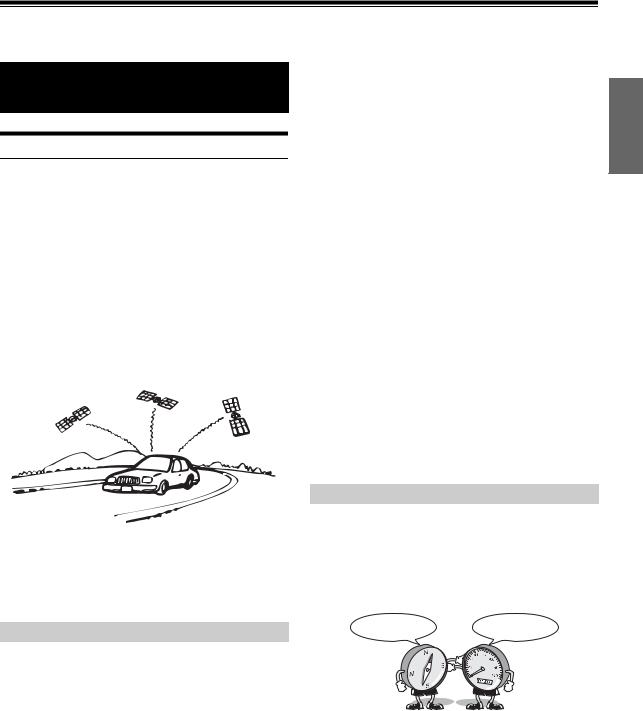
Getting Started
Preface
Navigation systems
This navigation system uses three different sensing devices to determine the present location and to track the progress of the vehicle. These three devices are: a GPS (Global Positioning System) receiver which receives digital signals from GPS satellites to determine the current position of the vehicle, a gyroscope which determines which direction the vehicle turns, and a speedometer pulse sensor which determine how far the vehicle has travelled. Because this system incorporates a gyroscope and a speed sensor, the system will be able to display the vehicle’s position and track the vehicle’s progress even in areas where the GPS signal may be blocked.
All map data is contained on a removable SD memory card. This system integrates this unique map database with the sensing devices to automatically plot out a route when a destination is entered. While driving, the navigation system guides you along the route with pictorial displays and verbal prompts.
•Altitude display accuracy can vary widely since the system uses only GPS signals for determining altitude approximations. Unlike altitude measurement, map matching accuracy is much more precise due to calculation methods that utilize three inputs: 1) GPS signals, 2) vehicle speed signals, and 3) the system’s built-in electronic gyro signals.
GPS (Global Positioning System)
This system receives signals from 3 or more GPS satellites (operated by the United States Department of Defense) orbiting at an altitude of 21,000 kilometers and measures the present car position using the same principles as triangulation. If the system receives signals from more than three GPS satellites, positioning becomes possible.
The GPS positioning system uses both three dimensional and two dimensional positioning.
Three dimension positioning
If GPS satellite reception is good, the positioning can be performed in three dimensions: latitude/longitude/altitude.
Two dimension positioning
When GPS satellite reception is less than optimal positioning is performed in two dimensions: latitude/longitude. In the latter case, since altitude cannot be determined, minor positioning discrepancies can occur three dimension positioning.
There may be a delay before the actual vehicle’s position is displayed
Determination of the present vehicle’s position starts when the ignition key is turned to the ACC or ON position, and ends when the key is turned OFF. When the key is first turned to the ACC or ON position delay of approximately one to two minutes is typical before the present vehicle’s position can be displayed.
The error from the actual position of the vehicle
When GPS signals can be received from 4 or more satellites, 3 dimensional positioning (altitude, latitude, and longitude) of the vehicle can be determined. In this case, error is in the range of 30 to 200 meters. When GPS signals can only be received from 3 satellites, only two dimensional positioning (latitude and longitude) can be determined, resulting in a slight increase in error. When GPS signals can only be received from less than three satellites, positioning of the vehicle through GPS is not possible. In addition to the inherent GPS error margin, the error rate may also increase if the United States Department of Defense deliberately changes its accuracy.
Locations where GPS signals are received easily
The optimum locations for receiving GPS signals are locations that command a good view where there are no tall buildings, trees, or other objects to obstruct the signals.
Gyroscope/ Speed sensor
The gyroscope is a sensor that accurately measures the angle by which the direction of a vehicle or other moving body changes.
Gyroscopes are used in inertial navigation systems for airliners and ships. In this navigation system, the gyroscope is used together with the speed sensor, making it possible to display the position of the vehicle even in locations where GPS signals may be blocked.
Direction |
Mileage |
13-EN

About car positional accuracy on initial use
Accurate Gyroscope/Speed sensor performance is not possible first without accumulating driving some data.
The car position may not be correctly displayed after initial installation of the system without inputting information about any previous changes (exchanging the tire, etc.).
The error margin between sensor information and GPS data (as calculated from the vehicle position) is continuously analyzed/revised, resulting in a gradual increase in system accuracy.
A measurement is constant even if GPS signals cannot be received avoiding the “filling of the gap” that occurs in running only the Gyro sensor.
Navigation Terminology
Navigation
The navigation system displays and tracks the vehicle’s position and movement on a moving map display. When a destination is input, the navigation system quickly calculates a route and guides you along the route with pictorial displays and voice prompts.
Present Vehicle Position
The present vehicle position is indicated by an arrowhead within a circle
Present vehicle position
Map matching
Since GPS navigation has an error window of about 30 m - 200 m, the position of your vehicle may be calculated in such a way that it is displayed incorrectly off the road. Map matching automatically corrects this error so that the position is displayed on the road.
Destination
The point on the map that is your destination is specified and displayed with the destination icon.
You can set up a destination and 4 waypoints for the same journey.
Route
When a destination is input, the navigation system automatically calculates a route and displays it in blue on the map
Route (Blue)
Destination icon
Address book
Locations you go to frequently can be stored into address book and marked on the map. The system can store up to 200 points. You can add icons at the marking locations so that the system also displays the icons on the map.
Mark
Motorway-preference selection
When searching for routes with the navigation system, you can switch between searching for routes that give priority to motorways and those that give priority to ordinary roads. When you specify motorway preference, the navigation system automatically searches for a route that gives priority to motorways and guides you along that route.
14-EN

Features
Large Touch-screen Monitor
This device is equipped with touch screen. Just touch the screen to operate this unit. You can also operate it using the remote control (sold separately).
18 Languages Selectable
You can choose one of the 18 languages for using this unit.
Automatic Route Calculation
Just select the destination and your navigation system does the rest, automatically searching for the route you need.
Real Time Voice Guide
A voice guide informs you of the distance and direction until your course changes, giving advice timed to match road conditions. <NAV> button lets you repeat the last voice guide when needed by just pushing the button.
The voice guidance may not be given if the vehicle’s present position is too near the destination.
Map Zooming
You can change the map display in 12 magnification scales.
3-Dimensional Map Display
A bird's eye view, 3-dimensional map can also be displayed.
Multiple-Destination Setting
You can set up to a destination and 4 waypoints in any order you like for the same journey.
Intersection Zoom (Auto Zoom Map)
As you near intersections and cross points, the map display automatically zooms in to show a more detailed view that you will need. This means there is no need to press the zoom buttons.
Direct Input of Name of Place of Interest
Input only the name of a place of interest (without inputting the city name) to search for the route to the place of interest.
Safety Camera Warning
This feature allows you to receive a warning when approaching a Road Safety Camera. You must ensure on your own liability that using this feature is legal in the country where you intend to use.
Dynamic Route Guidance Function
While following the route you have set, this function continuously searches for alternative routes to optimize travel time. The dynamic route guidance is performed based on TMC restriction events (accident, traffic congestion, etc.).
A message will be displayed to inform you that a route search to avoid a restriction district for a particular day, week, time and the detour point is made automatically.
Detour of Congestion Area
Areas in London, for example, where a congestion tax has been introduced, are shown in a different colour (scale less than 2 km). You can also search for a detour around a congested area.
Built-in Gyroscope and Speed Sensors
The gyroscope for sensing direction and the speed pulse sensor for detecting distance provide data which allows the vehicle position and direction to be displayed even in locations where the GPS signals cannot be received, such as between high buildings or in tunnels.
Built-in RDS-TMC Receiver
Real time traffic information from the Traffic Message Channel (TMC) will be automatically received. In the event of a traffic jam or traffic restriction, etc., you will be informed by voice and visual guidance. TMC traffic information is already broadcast in Austria, Andorra, Belgium, Switzerland, Czech, Germany, Denmark, Spain, France, Liechtenstein, Great Britain, Italy, Luxembourg, Monaco, Norway, Netherlands, San Marino and Vatican City.
•RDS-TMC information may not be received depending on FM radio reception and TMC service conditions.
Enjoying DVD with clear pictures
DVD-Video stored in high definition and high-quality sound format can be played. DivX® mode and ASF mode are supported.
Enjoying MP3/WMA/AAC player
CD-R/CD-RW/DVD-R/DVD-RW/DVD+R/DVD+RW or USB memory is playable.
iPod/iPhone Connection
You can connect iPod/iPhone using an optional cable (sold separately) and play back songs and video in iPod/iPhone.
15-EN
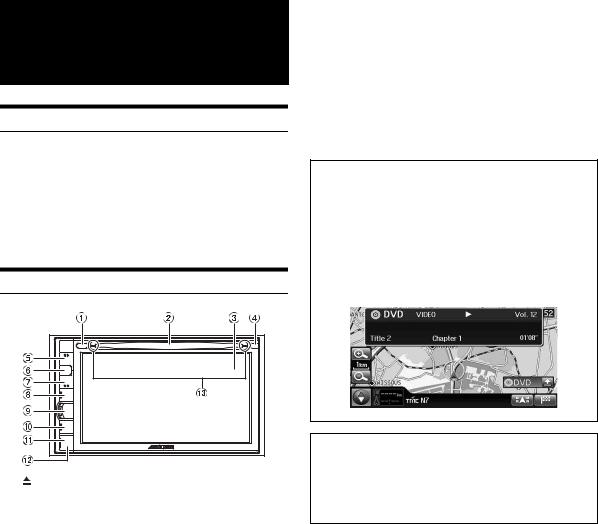
Before Using The
System
About This Navigation System
This system is shipped with an SD memory card that is already inserted into the system. The SD memory card contains the necessary data such as map data.
•Usually, you do not need to remove the SD memory card.
•If the SD memory card is malfunctioning for any reason, consult your nearest Alpine dealer.
•Do not insert the SD memory card into another device such as a computer. Doing so may cause data corruption.
Location of Controls
1 |
button |
Ejects a disc.
2Disc Slot
3Monitor
4Remote sensor / Dimmer sensor
•Point the optional remote control transmitter (RUE-4202) towards the remote sensor within a range of 2 meters. Some operations are possible in Audio/Visual mode.
•Senses the brightness of the car interior.
5 (VOL.)
(VOL.)
Turns up the volume of the audio/visual mode.
6MUTE
Activating this function will instantly lower the volume level by 20 dB.
7 (VOL.)
(VOL.)
Turns down the volume of the audio/visual mode.
8SOURCE / PWR
Displays the Audio/Visual screen. If the Audio/Visual screen is already displayed, changes the source. The unit turns off when you press the button for more than 3 seconds.
9MENU
Displays the Menu screen. When the system is in the navigation mode, displays the NAVIGATION screen. When the system is in the audio/visual mode, displays the AUDIO/ VISUAL screen.
0NAV
Displays the current position screen. While the system is performing route guidance, pressing the <NAV> button will repeat voice guidance.
!RESET switch
The system of this unit is reset.
@Front AUX Input Terminal
Connects a portable music player, etc., to the system. For details, see “Using the Front AUX Input Terminal” (page 18).
#Disc indicator
The light will turn off when a disc is inserted.
Optional Remote Control Interface Box
This unit is operable using the vehicle’s secondary radio controls. An Alpine Remote Control Interface Box (optional) is required. For details, contact your Alpine dealer.
Controllable with Remote Control
This unit can be controlled with an optional Alpine remote control (RUE-4202). Some operations are possible in Audio/ Visual mode. For details, consult your Alpine dealer.
Point the optional remote control transmitter at the remote control sensor.
About the button descriptions used in this Owner’s Manual
This Owner’s Manual uses square brackets to present a touch switch name (e.g. [Destination]), and uses angle brackets to present a button name on the body (e.g.
<MENU>).
16-EN
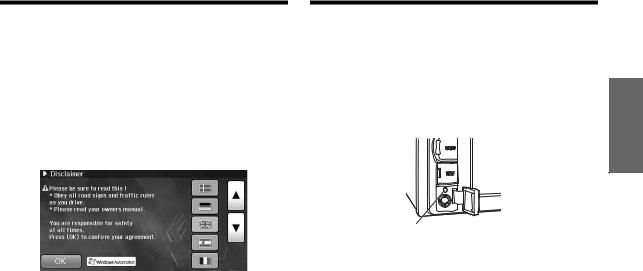
Turning the System On |
|
Initial System Start-Up |
With the Alpine navigation system, when the ignition key is turned to |
|
Be sure to press the RESET switch when using the unit for the first |
ACC or ON, the opening screen will be automatically displayed. |
|
time, after changing the car battery, etc. |
1 When the system is used for the first time, both the language selection menu and important information saying “Disclaimer” are displayed on the same screen. There are 18 languages to choose from. Touch [ ] or [
] or [ ] to scroll the list, and then touch the desired language.
] to scroll the list, and then touch the desired language.
1
2
Turn off the unit power.
Remove the cover.
After the language has been selected, important information is displayed in each language. Be sure to read the important information.
2 After you have read this important information, touch [OK].
The radio screen is displayed.
•Some of this unit’s functions cannot be performed while the vehicle is in motion. Be sure to stop your vehicle in a safe location and apply the parking brake before attempting these operations.
RESET switch
3 Press RESET switch with a ballpoint pen or similar pointed object.
17-EN
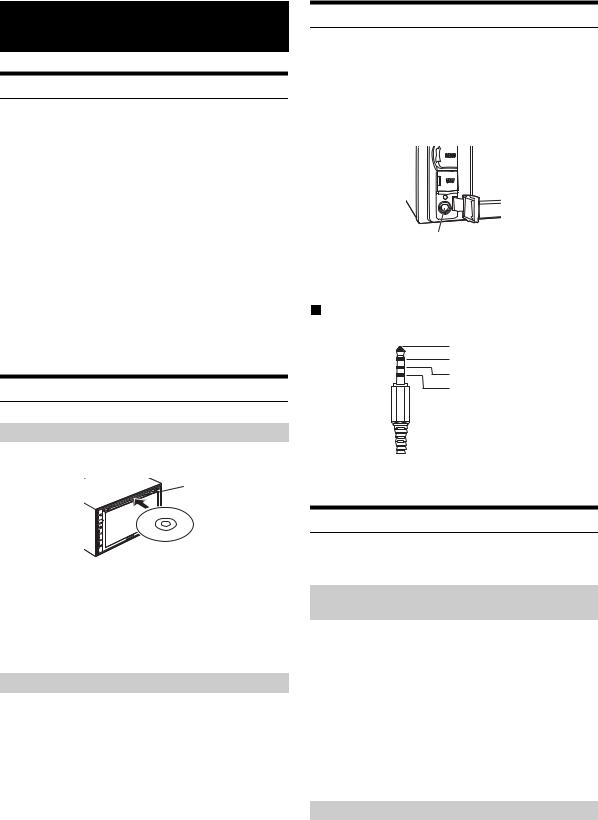
Basic Operation
Turning Power On or Off
1 Turn the ignition key to the ACC or ON position.
The system is automatically turning on. After turned on, the opening screen appears first and then the mode screen (map screen, radio screen, etc.) appears.
•When turned on, the system displays the last mode screen that was displayed before the ignition key was turned off. For example, when the navigation mode screen is displayed, if you turn off the ignition key and then turn it on, the system displays the navigation mode screen again.
2 To turn off the system, press and hold the <SOURCE/PWR> button for more than 3 seconds.
The system is turned off.
•The unit can be turned on by pressing any button on the unit, except
 (Eject).
(Eject).
Inserting/Ejecting a Disc
Inserting the Disc
1 Insert the disc with the label side facing up.
 Disc Slot
Disc Slot
When you insert the disc up to certain point, it is automatically pulled into the unit. The unit starts to play the disc.
•Do not touch the surface of the disc directly with your fingers.
•Before inserting or removing the disc, always turn the ignition key to ACC or ON. You cannot remove or insert the disc with the ignition key turned to OFF.
Removing the Disc
1 Press < >.
>.
When the disc has been ejected part way, take it out.
•If the disc cannot be ejected by pressing < >, press and hold <
>, press and hold < > again for at least 10 seconds.
> again for at least 10 seconds.
Using the Front AUX Input Terminal
Connect a portable music player, etc., by simply connecting it to the input on the front panel. An optional adapter cable is required (standard RCA to 3.5ø mini-phono plug or 3.5ø to 3.5ø mini phono plug).
You can also play back video connecting with an optional AV cable (4- pole mini AV plug to 3-RCA).
1 Remove the cover from the Front AUX Input Terminal.
Front AUX Input terminal
2 Connect a portable music player, etc., by using an optional adapter cable.
Usable 4-pole mini AV plug
The unit accepts the following 4-pole mini AV plug pin-out:
Audio L (White)
Audio R (Red)
Ground
Video (Yellow)
•Please check pin-out carefully before use of this product. Depending on the cable, there may be no picture and/or sound.
Adjusting the Volume
You can adjust the volume by the button on the body or the Setup screen.
Adjusting the volume of the Audio/Visual mode
1 Press < > or <
> or < >.
>.
 : Turns up the volume.
: Turns up the volume.
 : Turns down the volume.
: Turns down the volume.
•Navi MIX Level: The audio volume during the navigation guide can be set by adjusting the audio volume while the navigation guide continues. When the navigation guide finishes, the previous audio volume and the previous screen are restored. For example, if navigation cuts in when the volume is lower than the setting level, the volume during the navigation guide will be reset to the current listening volume. (When the navigation guide cuts in, the audio volume does not increase.)
Adjusting the volume of the Navi Guidance
Adjust on the Setup screen.
For details, see “Navi Guidance Volume Adjustment” (page 92).
18-EN
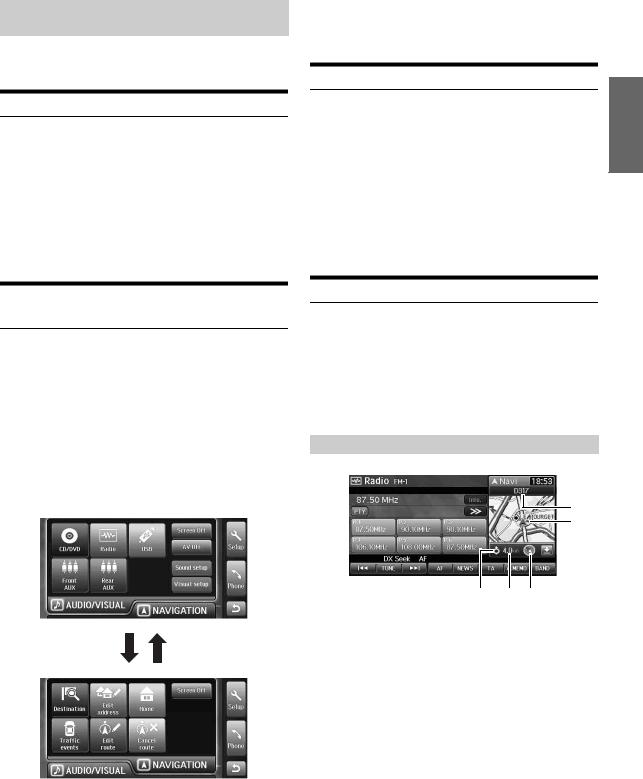
Adjusting the volume of the Sound (Beep) Guide
Adjust on the Setup screen.
For details, see “Sound (Beep) Guide Function” (page 92).
Lowering Volume Quickly
Activating the Audio Mute function will instantly lower the volume level by 20 dB.
1 Press <MUTE> to activate the MUTE mode.
The audio level will decrease by about 20 dB and “Mute” flashes.
2 Pressing <MUTE> again will bring the audio back to its previous level.
Changing between the NAVIGATION menu and the AUDIO/VISUAL menu
1 Press <MENU>.
The NAVIGATION menu screen or the AUDIO/VISUAL menu screen appears.
In the navigation mode, the NAVIGATION menu screen appears. In the audio/visual mode, the AUDIO/VISUAL menu screen appears.
2 To change to the NAVIGATION menu screen, touch the [NAVIGATION] tab.
To change to the AUDIO/VISUAL menu screen, touch the [AUDIO/VISUAL] tab.
Touch the |
Touch the |
[NAVIGATION] |
[AUDIO/VISUAL] |
tab. |
tab. |
If you press <MENU> on the MENU screen, the NAVIGATION menu screen and AUDIO/VISUAL menu screen are switched alternately.
•In this Owner’s Manual, the navigation instructions assume that the NAVIGATION menu screen appears when the <MENU> button is pressed. Also, the audio/visual instructions assume that the AUDIO/ VISUAL menu screen appears when the <MENU> button is pressed.
Touch operation
You can operate the system by using the touch panel on the screen.
•Be sure to touch the switch lightly with the pad of your finger on the display to protect the display.
•If you touch a switch and there is no reaction, remove your finger from the display once, and try again.
•Touch switches that cannot be operated appear dull in colour.
Common touch switches
 : Returns to the previous screen. Depending on the function, this switch may cancel the operations performed on the screen.
: Returns to the previous screen. Depending on the function, this switch may cancel the operations performed on the screen.
 : Closes the window.
: Closes the window.
Window operations
This system uses window displays on the map screen and the AUDIO/ VISUAL main screen.
In the NAVIGATION mode, the AUDIO/VISUAL Window is displayed, which allows you to perform simple operations in the AUDIO/VISUAL mode. In AUDIO/VISUAL mode, the current position screen is displayed.
Furthermore, you can change to the Info. Window to display the clock/ calendar.
Appearance of the NAVIGATION Window
 1
1
2 |
3 |
6 5 4
1The clock display
2The next guidance point name*
3The current position icon
4The direction
5The distance to the next guidance point*
6The turn direction at the next guidance point*
* Appears only when the system is providing route guidance.
•If a 3D map is displayed on the map screen, it changes to the 2D Heading Up display automatically.
19-EN
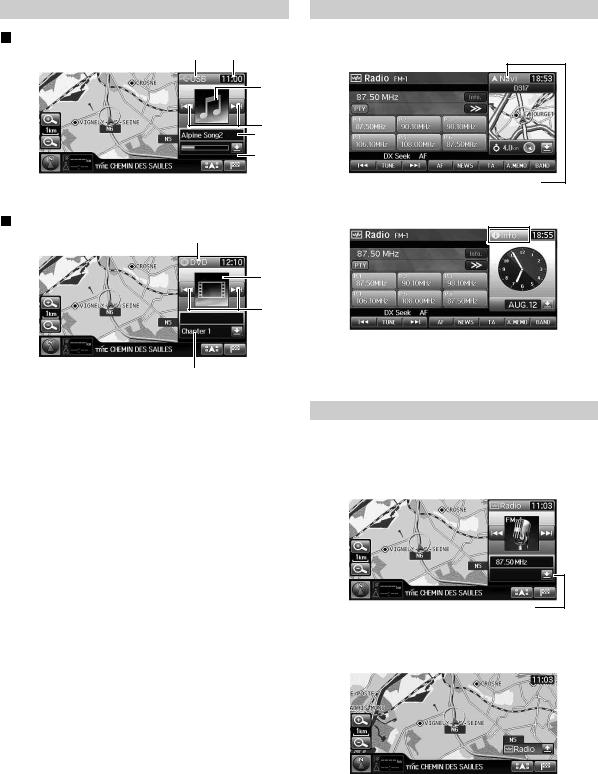
Appearance of the AUDIO/VISUAL Window
Audio mode view
1 2
3
4
 5
5
Visual mode view
1
 2 3
2 3
4
5
1[(mode name)] switch (The source display)
2The clock display
3The artwork/image display
4The UP/DOWN switch
The appearance and function of the UP/DOWN switch varies depending on the source.
Source |
Function |
|
|
DVD/CD/USB/iPod |
Changing Track/File/Chapter |
|
|
Radio/RDS |
• Distance mode/Local mode: |
|
Automatic tuning |
|
• Manual mode: Changing the |
|
channel |
|
• RDS mode: TA skip |
|
|
AUX |
– |
|
|
EXT.DVD Changer |
Changing Track |
|
|
DVB-T |
Changing Channel number / |
|
Favorite channel number |
|
|
5The information display
DVD: Chapter no.
iPod/MP3/WMA/AAC: Song Title/The playback elapsed time
indicator
CD: Track name, Current song no./Total song no./ The playback elapsed time indicator
Radio: Frequency, PS (Programme Service) Name
Changing to the Info. Window
1 Touch the [(mode name)] switch on the Window.
[(mode name)] switch
The Window changes to the Info. Window. The current time and the calendar are displayed.
2 Touch [Info.].
The window returns to the previous screen.
Resize the Window
You can change the Window size to mini size.
1 Touch the resize switch.
The window changes to mini size.
Resize switch
2 To restore the Window size, touch the resize switch once more.
20-EN
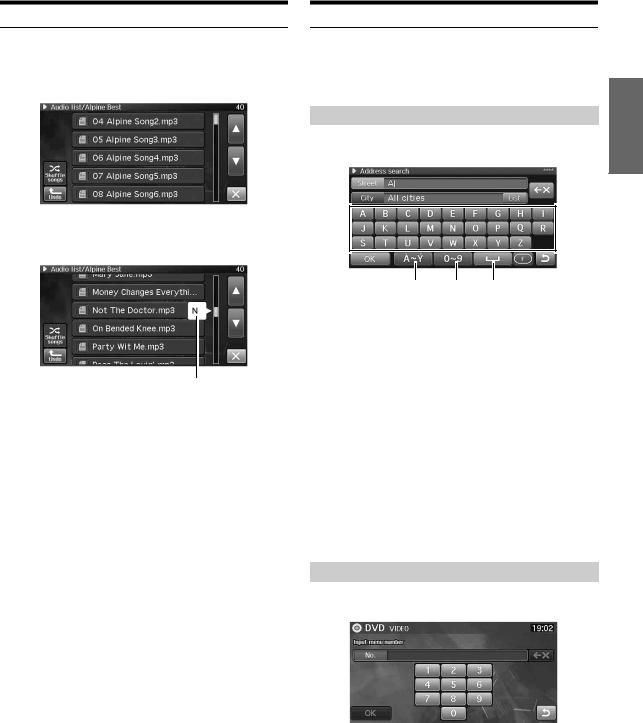
Selecting an Item in a List
To scroll through a list, perform the following operations.
1 Touch [ ] or [
] or [ ] to scroll items one by one up or down.
] to scroll items one by one up or down.
2 Touch and hold [ ] or [
] or [ ] to scroll quickly through the list.
] to scroll quickly through the list.
1*
There are 3 progressive levels of scroll speed.
At first, when you touch and hold, the list scrolls 4 lines per second. After holding for a while, the list scrolls 8 lines per second. After holding even further, the list scrolls 40 lines per second.
1When the list is arranged in alphabetical order, an initial letter appears while scrolling at the highest speed.
* This feature may not be available for some lists.
Using the On-Screen Keyboard
When you are required to input a character on the screen using the keyboard, the display changes to the keyboard. Use the displayed characters to input information. The following procedure explains how to select characters.
Entering characters
1 Touch the desired character.
 2
2
1
 3
3
4
6 7 5
1Text window
Displays the selected characters/numerals.
2 (Delete)
(Delete)
Returns to the previous character and erases it. Touching here for more than 2 seconds will erase all input characters.
3Character keypad
4OK
The selected character is set. The available characters, depending on the item, are shown in the list.
5 (Space)
(Space)
6Special character selector switch
Changes the character keypad to display additional characters.
7Number/symbol selector switch
Changes the character keypad to display numbers and symbols.
Entering number
1 Touch the desired number.
21-EN
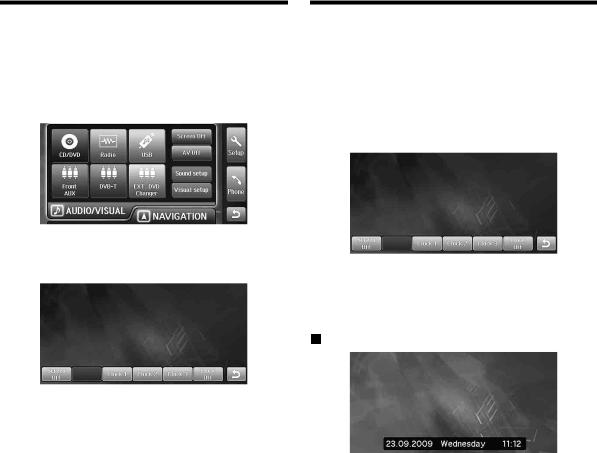
Turn off the Screen |
|
Setting the Clock Display |
You can turn off the screen.
1 Press <MENU>.
1 Press <MENU>.
2 Touch [Screen Off].
2 Touch [Screen Off].
3 Touch the screen to display the operation switch, then touch any of [Clock1] ~ [Clock3] or [Clock Off].
3 Touch the screen to display the operation switch, then touch [Screen Off].
The screen display is turned off.
•To cancel turning off the screen, touch the screen once more.
Clock1/Clock2/Clock3: Display the clock on the wallpaper. Clock Off: Do not display the clock on the wallpaper.
•Repeat steps 3 to change the clock display when the clock is displayed (or the screen is off).
Clock display example
22-EN
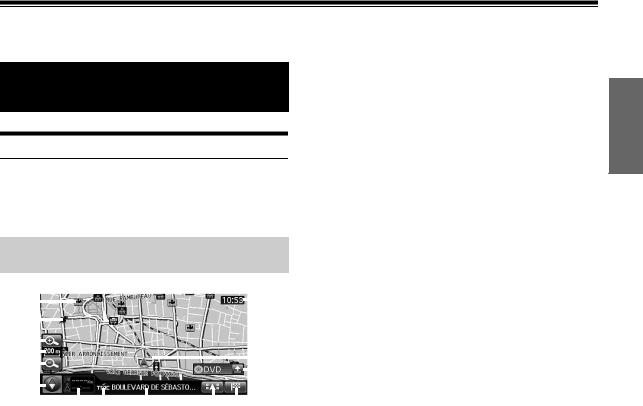
Navigation
Basic Operations
How to View a Navigation Screen
The map screen that shows the position of the vehicle is called the navigation screen. Normally, the vehicle is displayed at the centre of the map screen and the map is automatically scrolled according to the movement of the vehicle.
Current Vehicle Position Map (without route)
1 |
|
|
|
|
|
|
|
|
|
|
|
$ |
||
|
|
|
|
|
|
|
|
|||||||
|
|
|
|
|
|
|
||||||||
2 |
|
|
|
|
|
|
|
|
|
|
|
|
|
|
|
|
|
|
|
|
|
|
|
|
|
|
|
|
|
3 |
|
|
|
|
|
|
|
|
|
|
|
|
|
|
|
|
|
|
|
|
|
|
|
|
|
|
|
|
|
4 |
|
|
|
|
|
|
|
|
|
|
|
|
|
# |
|
|
|
|
|
|
|
|
|
|
|
|
|
||
5 |
|
|
|
|
|
|
|
|
|
|
||||
|
|
|
|
|
|
|
|
|
|
|
|
|
@ |
|
6 |
|
|
|
|
|
|
|
|
|
|
|
|||
|
|
|
|
|
|
|
|
|
|
|
|
|
|
|
|
|
|
|
|
|
|
|
|
|
|
|
|
|
|
|
|
|
|
|
|
|
|
|
|
|
||||
7 8 9 |
0 ! |
|
|
|
||||||||||
1POI Icons
The POI icons can be displayed on the map when map scale is 200 m (200 yards) or less.
2Address book Icons
The address book icons can be displayed at the entered locations on the map when map scale is 10 km (6 miles) or less.
3 (Zoom in)
(Zoom in)
Enlarges the map scale.
4Map scale
5 (Zoom out)
(Zoom out)
Reduces the map scale.
6Compass Icon
This indicates the orientation of the map. When you set the direction in which the vehicle is moving to up, the red triangle points north.
The icon’s color circle also indicates whether the current
GPS position is available or not.
 : The current GPS position is available.
: The current GPS position is available.
 : The current GPS position is not available.
: The current GPS position is not available.
7Destination information switch
When setting the route, you can change to the manoeuvre list screen by touching this switch. For details, see page 26.
8TMC indicator
For details, see page 53.
9Street name
0  switch
switch
Displays/hides the POI Icons. For details, see page 27.
! switch
switch
Displays the Destination screen. You cannot touch the switch while you are driving. For details, see page 30.
@AUDIO/VISUAL window
For details, see page 19 and 20.
#Vehicle position icon
 : This indicates the current position of the vehicle.
: This indicates the current position of the vehicle.
 : This indicates the direction in which the vehicle is moving.
: This indicates the direction in which the vehicle is moving.
$ Clock display
Current time received from GPS is displayed. See “Clock Setup” (page 94).
• Building outline is displayed on the 50 m (50 yards) scale map.
23-EN
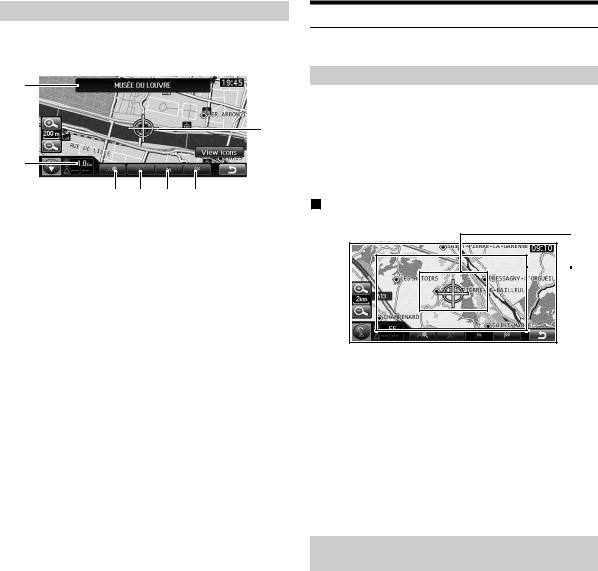
Point Display
The point display appears on the screen after you have scrolled the map. For how to find a destination by scrolling the displayed map, see “Finding a Destination by Scrolling Displayed Map” on page 37.
8
7
 6
6
1
2 3 4 5
1Distance from the current vehicle position
Distance in a straight line from the current vehicle position.
2 switch
switch
You can search for facilities in the vicinity of the crosshair icon on the map. For details, see “Finding facilities in the vicinity of the specified location by Scrolling the Displayed Map” (page 38).
3  switch
switch
Save the cross hair icon’s position as Home, enters the position into the address book, or sets the position as the current position. For details, see “Save as Home” (page 41), “Save as Address Book” (page 41) or “Set as Current Position” (page 40).
4  switch
switch
Adds the cross hair icon’s position as a waypoint. For how to add a waypoint, see “Add a Waypoint” (page 42).
5  switch
switch
Sets the cross hair icon’s position as the destination. For how to set the destination, see “Finding a Destination by Scrolling Displayed Map” (page 37).
6[View icons] switch
Appears only when the cross hair icon lays on a POI icon. You can touch the switch to display. See “Finding a Destination by POI icon” (page 38).
7Crosshair icon
Align the crosshair icon over the place to be searched by scrolling the map.
8Details on the crosshair icon
Street names, addresses and POIs (Point of interest) are displayed.
• The selected street’s colour changes (scale less than 1 km/800 yards).
Displaying a Desired Place
You can search a map for a desired place by scrolling it.
Scrolling the Map
1 Touch the Map Display.
The map continues to scroll while you touch the map display.
When you release the display, the screen becomes the scroll screen in which the straight distance from the current position is displayed.
Scroll speed changes depending on the screen area you are touching.
1
 2
2
 3
3
1Area 1
Scrolls slow.
2Area 2
Increases the scroll speed in three stages in accordance with how long you touch the screen.
3Area 3
Scrolls quickly.
•You can not scroll continuously while driving for your safety.
•Scrolling a 3D map changes it to a 2D map. See “Changing the Map Orientation” (page 25).
•The <NAV> button returns you to the current car position map.
•Scrolling is not available in the manoeuvre list screen.
Displaying the Current Vehicle Position
Map
The screen returns to the present peripheral map after when the map is scrolled, other maps are displayed for searching destination, and the menu screen is displayed.
1 Press <NAV>.
The current car position screen is displayed.
24-EN
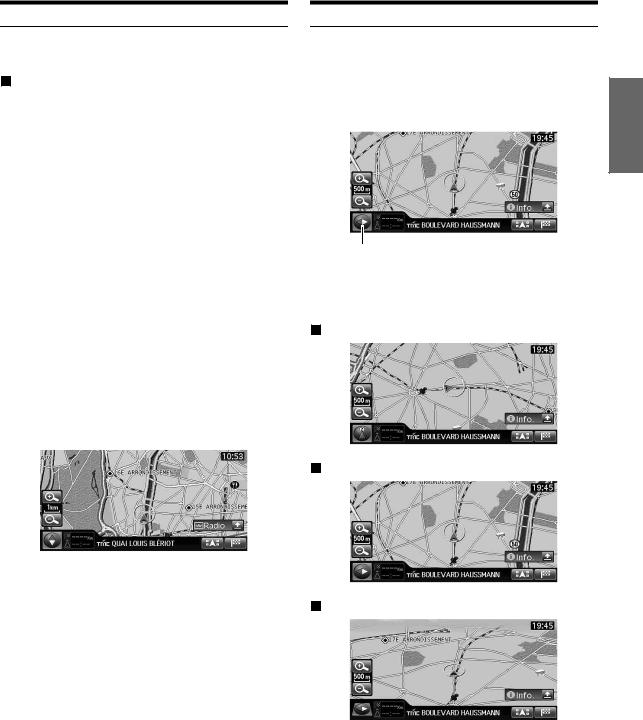
Changing the Map Scale
The map scale can be adjusted from 50 m (50 yards) to 200 km (120 miles).
Map scale
Metric (km/m) |
Imperial (mile/yard) |
|
|
200 km |
120 miles |
|
|
100 km |
60 miles |
|
|
50 km |
30 miles |
|
|
20 km |
12 miles |
|
|
10 km |
6 miles |
|
|
5 km |
3 miles |
|
|
2 km |
1 miles |
|
|
1 km |
1/2 miles (800 yards) |
|
|
500 m |
500 yards |
|
|
200 m |
200 yards |
|
|
100 m |
100 yards |
|
|
50 m |
50 yards |
|
|
•For some locations, the map scale is automatically adjusted according to the map data.
•You can change between kilometers or miles in setup, see page 94.
1 Change the map magnification ratio by touching [  ] (zoom in) or [
] (zoom in) or [  ] (zoom out).
] (zoom out).
This changes rapidly by touching and holding either switch.
Changing the Map Orientation
The map orientation can be set for either north up, or your current direction heading up. A 3-dimensional map can also be displayed. The icon in the lower left of the screen above the map scale icon indicates the current orientation.
1 Touch the Compass icon.
Compass Icon
Each time you touch the Compass icon, the direction of the map changes.
North up Heading up 3D map North up
North up map
Heading up map
•The building outlines can be displayed on the map when map scale is 50 m (50 yards) or less.
•The POI icons can be displayed when map scale is 200 m (200 yards) or less.
•POI Warning icons can be displayed on the map when map scale is 500 m (500 yards) or less.
•Custom POI icons can be displayed on the map when map scale is 200 m (200 yards) or less.
•The 3D map will automatically be switched to heading up.
3D map
•The viewing angle for the 3D map can be adjusted. See “Adjusting the 3D view angle” (page 100).
•When the 3D map is scrolled, it changes automatically to 2D map (heading up).
25-EN
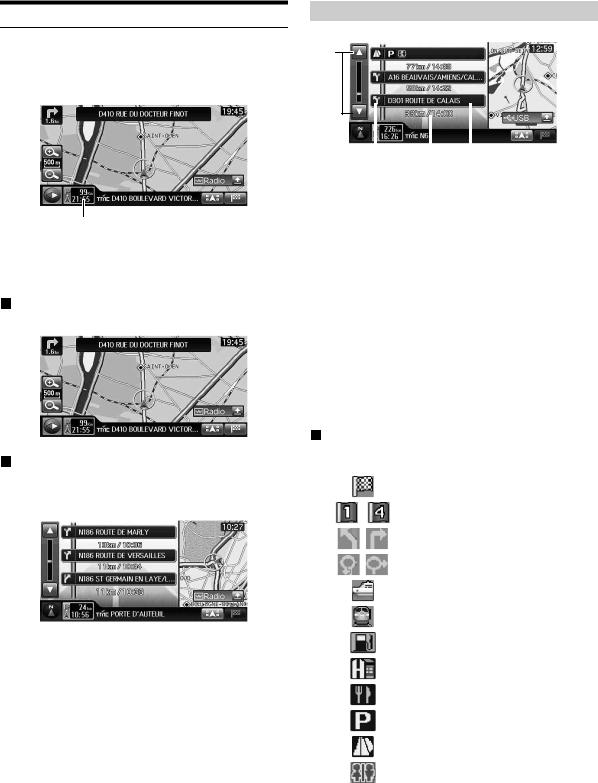
Changing the Map Mode
The map mode can be changed according to the situation.
1 When the route is set, touch the Destination information switch.
Destination information switch
Each time you touch the Destination information switch, the map mode changes.
Map screen Manoeuvre list screen Map screen
Map screen
The regular map is displayed.
Manoeuvre list screen
During the route guide, the distance between the guide point ahead and the current position is displayed on the left. The map is displayed on the right.
•The right map always shows the vehicle position (it cannot be scrolled).
•The Manoeuvre list screen cannot be displayed if the destination is not set.
•Roundabouts are also displayed in the Manoeuvre list screen. When the destination or a waypoint is set on a roundabout, the roundabout is displayed ahead of the destination/waypoint.
•The map display on the right side of the screen switches the head up display when the screen displays the 3D map.
About the Manoeuvre List Screen
a
|
|
|
|
|
|
|
|
|
|
|
|
|
|
|
|
|
|
|
|
|
|
|
|
|
|
|
|
|
b |
c |
d |
|||
a  /
/ 
Touch [  ] or [
] or [  ] to scroll the manoeuvre list.
] to scroll the manoeuvre list.
bTurn direction at the guidance point.
cDistance to the next guidance point / the required time
dName of guidance point
Scrolling the Manoeuvre List
1 Touch [  ] or [
] or [  ].
].
You can touch [  ] to display the next manoeuvre list, and [
] to display the next manoeuvre list, and [  ] to display the previous manoeuvre list. You can also touch and hold to scroll the manoeuvre list continuously.
] to display the previous manoeuvre list. You can also touch and hold to scroll the manoeuvre list continuously.
2 To return from the manoeuvre list to the present location, press <NAV>.
Information shown about a rest area, etc.
Symbol |
Legend |
|
|
|
Destination |
|
|
~ |
Waypoint |
|
|
|
Intersection with guidance |
|
|
|
Roundabout with guidance |
|
|
|
Ferry terminal |
|
|
|
Train station |
|
|
|
Petrol station |
|
|
|
Hotel |
|
|
|
Restaurant |
|
|
|
Car park |
|
|
|
Rest area |
|
|
|
Toilet |
|
|
26-EN
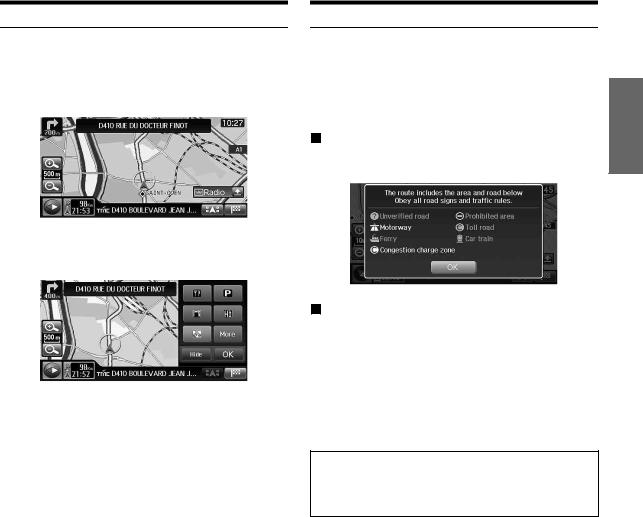
Display the POI Icon
You can display the POI Icon on the map. You can also display the POI Icon in the Setup screen.
Refer to “Setting the POI Icon Display” (page 101) on Setup.
1 Touch [  ] on the present location screen.
] on the present location screen.
The POI selection screen is displayed.
2 Touch the desired POI icon.
•Touch [More] to select the POI Icon in all categories. After this operation, refer to step 2-4 of “Setting the POI Icons Display Category” (page 102).
3 Touch [OK].
The selected POI Icon is displayed on the map.
•Touch [Hide] in step 2 to hide the POI Icon. The [Hide] switch changes [Show]. Touch [Show] to display the POI Icon again.
•The POI icons can be displayed on the detailed map with 200 m (200 yards) or less of scale.
About Congestion Areas
Areas in London, for example, where a congestion tax has been introduced, display streets in a different colour on the map (scale 2 km/1 mile or less). You can also search for a detour of a congested area.
•To automatically find a congestion area detour during a search, set “Congestion charge zone” to Off in the road preference setting. For details, see page 39.
If “Congestion charge zone” is set to Off
If the destination is set in a congestion area and a route is searched, a confirmation message is shown.
If “Congestion charge zone” is set to On
Even if the destination is set in a congestion area, the route is searched as usual.
•When the current vehicle position is in a congestion area, a route is searched, regardless of the congestion area setting.
•If “Congestion charge zone” is set to Off after the destination has been set for a congested area, an alternate route through the congested area will be searched. If you want to avoid the congested area, do another search, setting the destination outside the congested area.
 Caution
Caution
If “Congestion charge zone” is set to Off, in searching for a route through a congested area, decide your own detour route.
27-EN
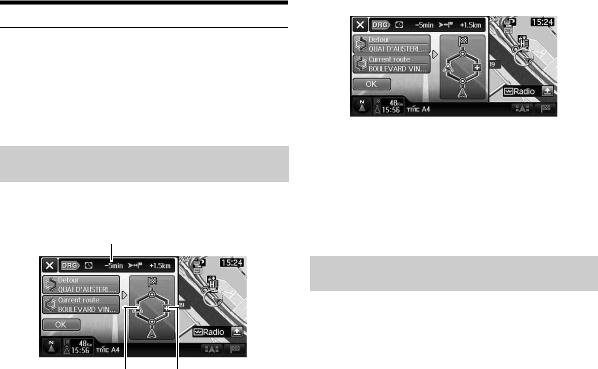
About Dynamic Route Guidance
The DRG (dynamic route guidance) updates traffic changes from moment to moment, providing you with a more accurate anticipated arrival time.
The dynamic route guidance is performed based on TMC restriction event (accident, traffic congestion, etc.). When an optimal route is found, the message is shown in the display and automatically changes the route (when the DRG is set to Auto). For details, refer to page 103.
If the Dynamic route guidance is set to Manual
If an optimal route is found using the dynamic route guidance function, the DRG screen appears. You can select a Detour route or the Current route.
1
2
3
4
56
1DRG information display
The time reduction and distance reduction/increase appear.
2 switch
switch
Close the DRG screen display and continue the guidance along the current route.
3Detour route selection switch
The street name is displayed.
4Current route selection switch
The street name is displayed.
5Current route information display
The TMC event icon that causes the detour is displayed.
6Detour route information display
The distance reduction/increase indication icons
 : The distance will be increased compared with the current route distance.
: The distance will be increased compared with the current route distance.
 : The distance will be reduced compared with the current route distance.
: The distance will be reduced compared with the current route distance.
 : The distance will be equal to the current route distance.
: The distance will be equal to the current route distance.
1 Touch [Detour] or [Current route].
2 Touch [OK].
The route is changed or remains on the current route, and the guidance starts.
•If there is no operation for 30 seconds, the current route is selected.
•While the DRG screen is displayed, if you drive along the detour route, the detour route is selected. If you drive along the current route, the current route is selected.
If the Dynamic Route Guidance is set to Auto
If an optimal route is found using the Dynamic Route Guidance function, the route will be automatically changed to a new route.
•The distance for a newly searched route may be longer than the current one.
28-EN
